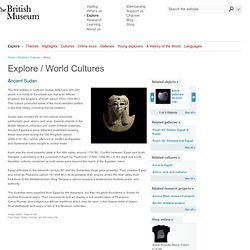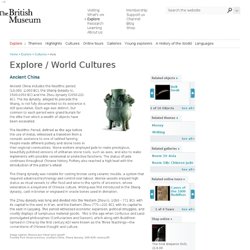

Jōmon period. Characters for Jōmon (meaning "cord marks" or "cord-patterned") The Jōmon period (縄文時代, Jōmon jidai?)

Is the time in Prehistoric Japan from about 12,000 BC[1] and in some cases cited as early as 14,500 BC[2] to about 300 BC, when Japan was inhabited by a hunter-gatherer culture which reached a considerable degree of sedentism and cultural complexity. The name "cord-marked" was first applied by the American scholar Edward S. Morse who discovered sherds of pottery in 1877 and subsequently translated it into Japanese as jōmon.[3] The pottery style characteristic of the first phases of Jōmon culture was decorated by impressing cords into the surface of wet clay. This pottery, dated to around 16,000 years ago, is perhaps the oldest in the world (pottery nearly as old has been found in southern China, the Russian Far East, and Korea[4]).
Chronology[edit] Incipient and Initial Jōmon (14,000–4,000 BC)[edit] Japan's Ancient Underwater "Pyramid" Mystifies Scholars. The district of Yonaguni officially owns the formations, and tourists and researchers can freely dive at the site.

Some experts believe that the structures could be all that's left of Mu, a fabled Pacific civilization rumored to have vanished beneath the waves. On hearing about the find, Kimura said, his initial impression was that the formations could be natural. But he changed his mind after his first dive. "I think it's very difficult to explain away their origin as being purely natural, because of the vast amount of evidence of man's influence on the structures," he said. (Related: "Pyramid in Bosnia—Huge Hoax or Colossal Find?
" For example, Kimura said, he has identified quarry marks in the stone, rudimentary characters etched onto carved faces, and rocks sculpted into the likenesses of animals. Ancient Sudan. The first settlers in northern Sudan date back 300,000 years.

It is home to the oldest sub-Saharan African kingdom, the kingdom of Kush (about 2500-1500 BC). This culture produced some of the most beautiful pottery in the Nile valley, including Kerma beakers. Sudan was coveted for its rich natural resources particularly gold, ebony and ivory. Several objects in the British Museum collection are made of these materials. Ancient Egyptians were attracted southward seeking these resources during the Old Kingdom (about 2686-2181 BC), which often led to conflict as Egyptian and Sudanese rulers sought to control trade. Ancient China. Ancient China includes the Neolithic period (10,000 -2,000 BC), the Shang dynasty (c. 1500-1050 BC) and the Zhou dynasty (1050-221 BC).

The Xia dynasty, alleged to precede the Shang, is not fully documented so its existence is still speculative. Each age was distinct, but common to each period were grand burials for the elite from which a wealth of objects have been excavated. The Neolithic Period, defined as the age before the use of metal, witnessed a transition from a nomadic existence to one of settled farming. People made different pottery and stone tools in their regional communities. Stone workers employed jade to make prestigious, beautifully polished versions of utilitarian stone tools, such as axes, and also to make implements with possible ceremonial or protective functions. The Shang dynasty was notable for casting bronze using ceramic moulds, a system that required advanced technology and control over labour. Ancient and Early Medieval South Asia. South Asia is the seat of many of the world’s great religious traditions, most notably Buddhism, Hinduism and Jainism.

Objects from the British Museum collection displayed in Room 33 explore the central beliefs of these faiths and their development from the early centuries CE to modern times. Buddhism was established in the fifth century BCE by the Buddha or ‘enlightened one’. However it was not until the third century BCE that Buddhism enjoyed royal patronage under the Mauryan kings – notably Ashoka – and spread to all parts of the subcontinent. Buddhism continued to flourish in subsequent centuries, reaching South East Asia in the fifth century CE and Tibet in the seventh. Ancient Near East.